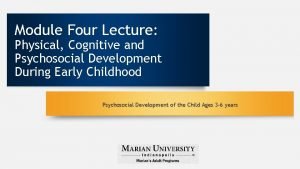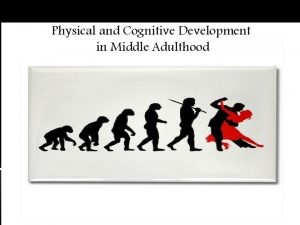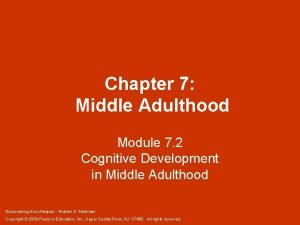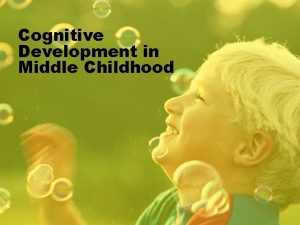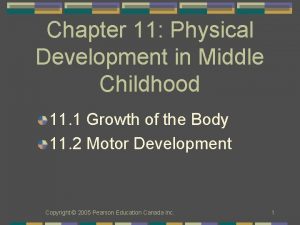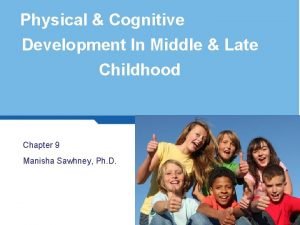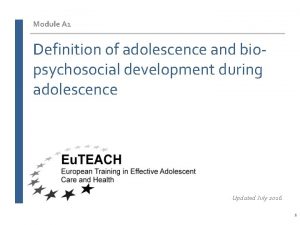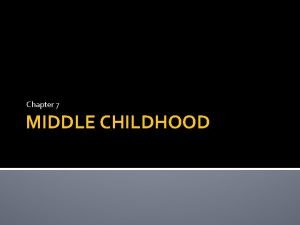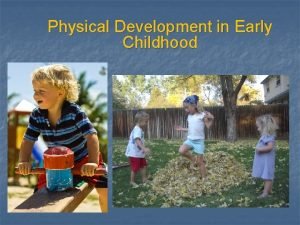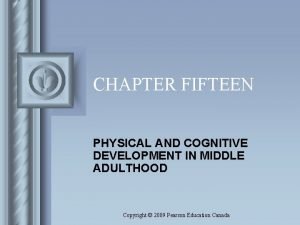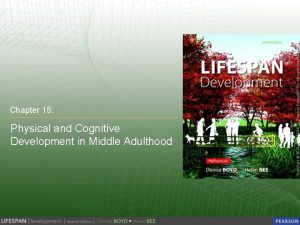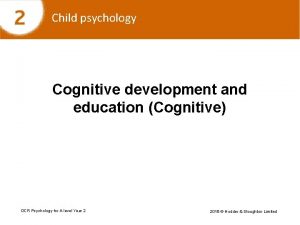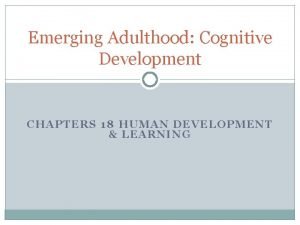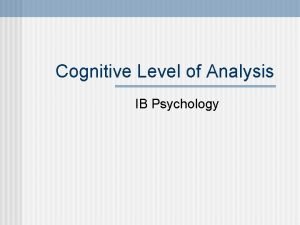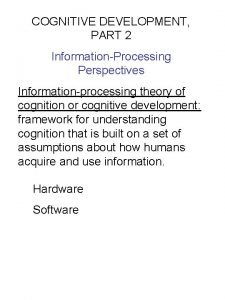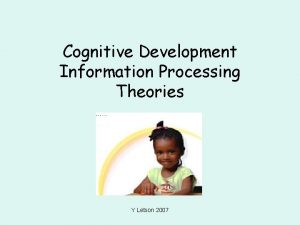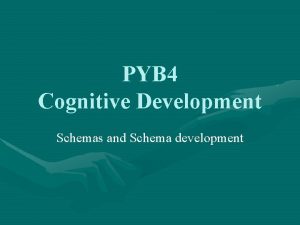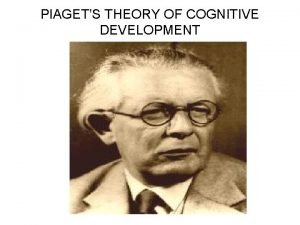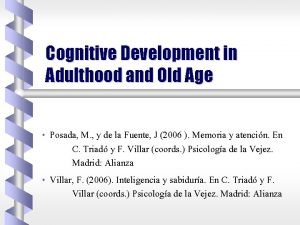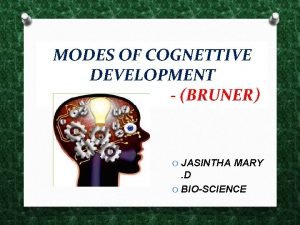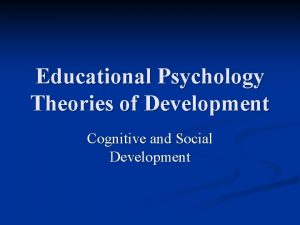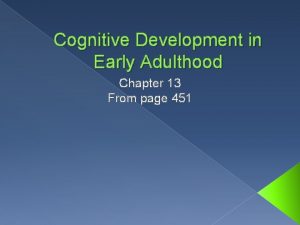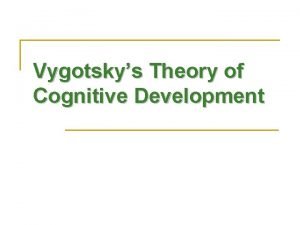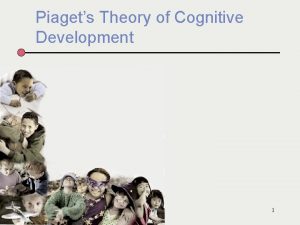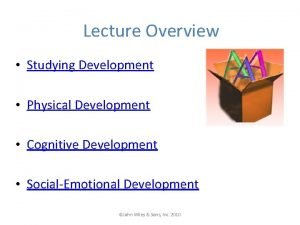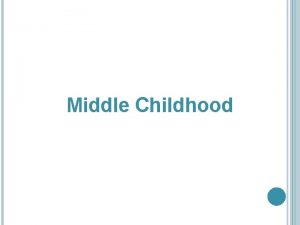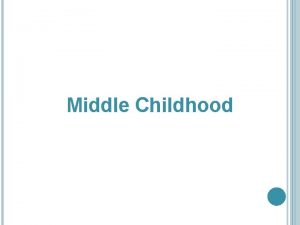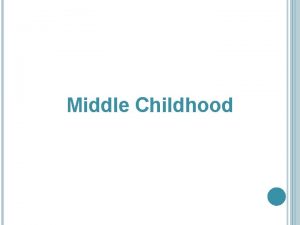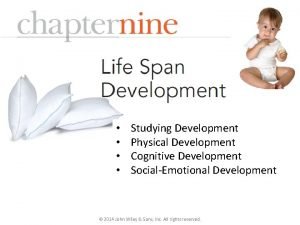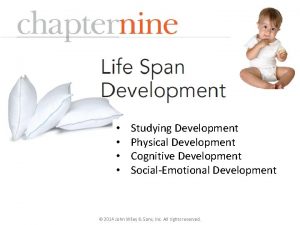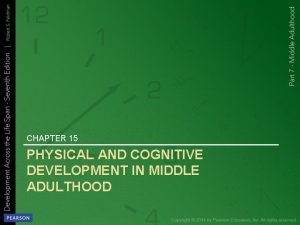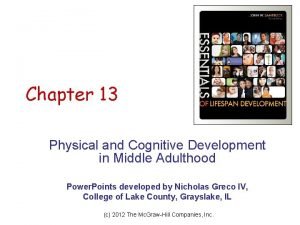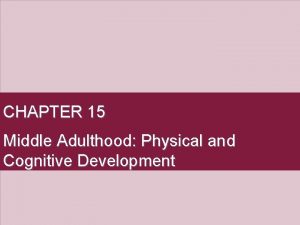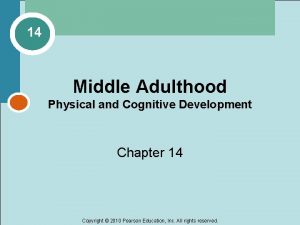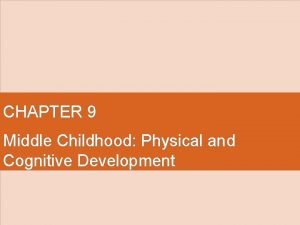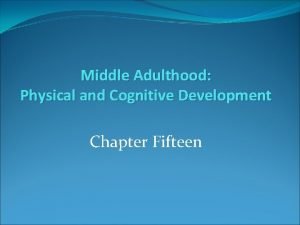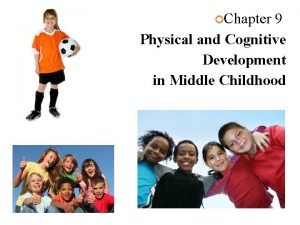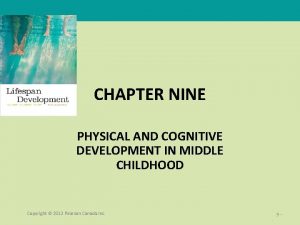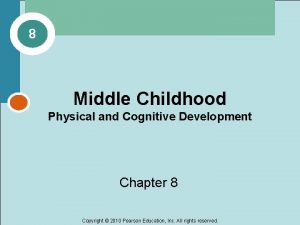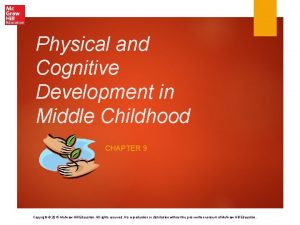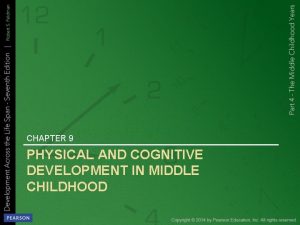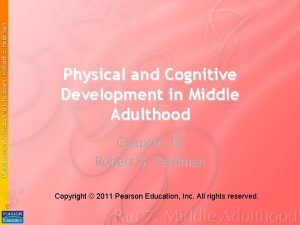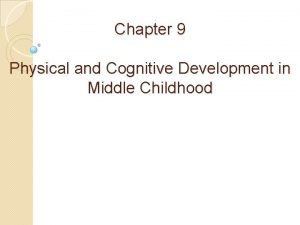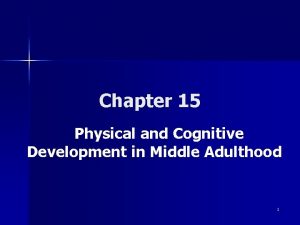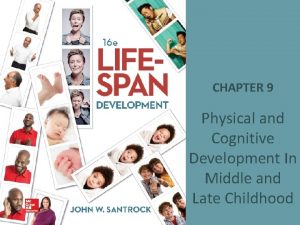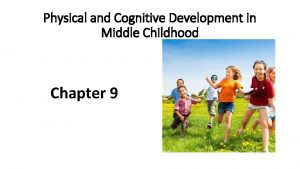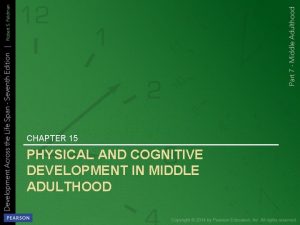Chapter 15 Physical and Cognitive Development in Middle















































- Slides: 47

Chapter 15: Physical and Cognitive Development in Middle Adulthood

IN THIS CHAPTER • Physical Changes • Health and Wellness • Cognitive Functioning

LEARNING OBJECTIVES 15. 1 What do researchers know about brain function in middle age? 15. 2 How does reproductive function change in men and women in middle age? 15. 3 What is osteoporosis, and what factors are associated with it? 15. 4 How do vision and hearing change in middle age? 15. 5 How does cardiovascular disease develop? 15. 6 What factors contribute to cancer? 15. 7 What are some important differences in the health of middle-aged men and women? 15. 8 How are socioeconomic status and ethnicity related to health in middle adulthood?

LEARNING OBJECTIVES (con’t) 15. 9 What are some of the consequences of alcoholism for middle-aged adults? 15. 10 How do Denney’s and the Balteses’ models explain the relationship between health and cognitive functioning in middle age? 15. 11 What has research revealed about the link between health and cognitive functioning? 15. 12 How do young and middle-aged adults differ in performance on memory tests? 15. 13 What does research suggest about agerelated changes in creativity?

PHYSICAL CHANGES Diverse Physical Development in Middle Adulthood • Primary aging • Secondary aging • More research on midlife is needed!

PHYSICAL CHANGES The Brain and Nervous System Cognitive tasks activate a larger area of brain tissue Cognitive processing is less selective; react more slowly to cognitive tasks Less ability to control attention inhibits responses to irrelevant stimuli Sensory stimuli processed differently

PHYSICAL CHANGES The Brain and Nervous System Behavioral choices and mental health affect the brain. • Circulatory system health affects parts of the brain involved with memory, planning, and processing speed.

PHYSICAL CHANGES The Reproductive System: Males Climacteric: loss of reproductive capacity • Slight decline in the quantity of viable sperm produced • Very slow drop in testosterone • Erectile dysfunction or impotence increases.

PHYSICAL CHANGES Menopause in Women • Timing • Cessation of menses • Secular trend

PHYSICAL CHANGES Menopause Phases Premenopausal phase Perimenopausal phase Postmenopausal phase

PHYSICAL CHANGES Hormone Therapy (HT) Hormone therapy: progesterone and estrogen administration • Women’s Health Initiative Study • Protocol • Findings

THE PROS AND CONS OF HORMONE THERAPY (HT) Results from Women’s Health Initiative (WHI, 2002) • PROS • Reduction of hot flashes • Protection against osteoporosis • CONS • Long-term use is related to increased risks of breast and ovarian cancers. • No protection against cardiovascular disease

You Decide which of these two statements you most agree with and think about how you would defend your position: 1. Due to the risks involved, hormone therapy should be a last resort for menopausal women who have hot flashes and other symptoms. 2. No medical treatment is entirely free of risk, so women who want to take hormone therapy to relieve symptoms of menopause should do so.

PHYSICAL CHANGES Menopause: Psychological Effects Research is mixed regarding menopausal effects. • Negativity and overall life stressors affect moods. • Severe symptoms of sleep deprivation may related to additional anxiety. • Ethnic influences

PHYSICAL CHANGES Menopause: Psychological Effects Does ethnicity influences attitudes about menopause and aging?

PHYSICAL CHANGES Menopause: Sexual Activity Most women remain sexually active, but with some decline in frequency. • Demands of other roles compete with time for sex. • Increasing illnesses explain declines.

PHYSICAL CHANGES Skeletal System • Osteoporosis begins around 30 for women—and men • Loss of estrogens and progesterone in women • Improved by regular weight-bearing exercise

RISK FACTORS FOR OSTEOPOROSIS

PHYSICAL CHANGES Vision: Loss of Visual Acuity Presbyopia: farsightedness • The eye lens thickens. • The total amount of light reaching the retina decreases. • Reduced focus adjustment

PHYSICAL CHANGES Hearing Presbycusis: the auditory nerve and structures in the inner ear gradually deteriorate. • Accelerates after 55 • Occurs in high and low frequencies • Both primary aging and secondary aging effects occur.

STOP AND THINK Why is there a different stereotype about the use of glasses versus hearing aids?

FILL IN THE BLANK No single variable affects quality of life in middle and late adulthood as much as _____.

HEALTH AND WELLNESS Cardiovascular Disease (CVD) Overview CVD: disease process in heart and circulatory system that accounts for 27 percent of yearly death • Myocardial infarction and atherosclerosis • The majority of Americans have at least one risk factor; risks are cumulative. • Available laboratory tests measure levels of Creactive protein (CRP ) in the bloodstream and can indicate that an individual has an undiagnosed buildup of plaque. • Administration of statin drugs may reverse plaque build-up and reduced heart attack risk by 54 percent.

HEALTH AND WELLNESS Cardiovascular Disease: Personality and Health Friedman and Rosenman Personality Patterns • Type A • Type B • Type D

WAIT A MINUTE! DID YOU SAY “TYPE D”?

RISK FACTORS FOR HEART DISEASE AND CANCER • Smoking • Blood pressure • Weight • Cholesterol • Inactivity • Diet • Alcohol • Heredity See Table 15. 2 (p. 384) for additional information.

HEALTH AND WELLNESS Cancer Second Leading Cause of Death for Adults 45+ Years of Age • Risk factors similar to those for heart disease • Good health habits early on reduce risks. • The dietary fat role is a controversial risk factor. • Some cancer is caused by viruses and infectious agents (i. e. , Helicobacter pylori).

HEALTH AND WELLNESS Gender and Health Men’s life expectancy is less than women’s. • Men have fewer diseases and disabilities that limit daily activity. • Men die of CVD at higher rates than women do. Women have a greater ability to recover. § Women recover higher levels of physical functioning from heart attacks than men do.

HEALTH AND WELLNESS Socioeconomic Class, Race, and Health • Social class discrepancies in secondary aging • Occupational level and education differences • Ethnicity related to overall health

HEALTH AND WELLNESS Ethnicity and Gender: Cardiovascular Disease Cardiovascular disease: heart attack and stroke • Ethnicity influences • Risk factors by gender

HEALTH AND WELLNESS Socioeconomic Class, Ethnicity, and Health Diabetes • Growing for all racial groups • Risk factor for CVD, blindness, and kidney failure • Race differences

HEALTH AND WELLNESS Socioeconomic Class, Ethnicity, and Health Cancer • Incidence and race • Failure to receive screening and care • Prevention strategies

HEALTH AND WELLNESS Alcoholism: physical and psychological dependence on alcohol • Incidence by gender • Risk (alcohol x aging) • Long-term effects

INTERNET ADDICTION DISORDER Internet addiction (IAD): person must demonstrate a pattern of internet use that interferes with normal educational, occupational, and social functioning • Often involves disorder of impulse control; often coupled with other types of disorders (e. g. , compulsive behavior patterns) • Can also be part of symptom set that includes depressive behavior Treatment Approach • Acceptance and Commitment Therapy (ACT)

Critical Analysis 1. In your view, why is the internet a more attractive means of “escaping” from the stresses of everyday life than books, movies, and other forms of entertainment? 2. How can researchers determine whether depressive symptoms drive internet use or spending large amount of time online produces such symptoms?

COGNITIVE FUNCTIONING Overview Cognitive loss and cognitive improvement Role of knowledge and experience Compensation

COGNITIVE FUNCTIONING Physical and Cognitive Aging Denny’s Model of Physical and Cognitive Aging • Typical curve of age-related changes • Effects of exercise of the skill or ability • Underlying age-related decay curves Let’s take a closer look!

DENNEY’S MODEL OF PHYSICAL AND COGNITIVE AGING Figure 15. 2 Denney’s Model of Physical and Cognitive Aging

COGNITIVE FUNCTIONING Physical Decline and Compensation Baltes and Baltes’s Model of Selective Optimization • Physical declines create selective optimization with compensation to combat aging effects. • Selective optimization strategies

HEALTH AND COGNITIVE FUNCTIONING Schie’s Analysis of Seattle Longitudinal Study • Earlier cardiovascular disease is related to earlier and larger declines on intellectual tests. • Exercise lowers mortality risks. • Physical activity is related to maintenance of cognitive functions.

COGNITIVE FUNCTIONING Memory: subjective experience of forgetfulness • Visual memory • Overcoming perceived memory limitations

COGNITIVE FUNCTIONING Semantic and Episodic Memories Do you know the difference? Episodic memories slow with age, but not semantic memories Semantic memories

COGNITIVE FUNCTIONING Practiced and Unpracticed Skills Why does practice matter? • Helps maintain or gain cognitive skill • Helps compensate for age-related deficits in cognitive functioning • Provides practice with different strategies to remember expository text

COGNITIVE FUNCTIONING Creativity: the ability to produce original, appropriate, and valuable ideas or solutions to problems • Simonton studied creativity and productivity in the work of thousands of notable scientists. • Best work produced around age 40; outstanding work published in their 50 s What will you be doing when you are 40 years old?

COGNITIVE FUNCTIONING Creativity Goleman’s stages focus on divergent thinking. Illumination (the aha! moment) Preparations Incubation Translation

MAINTAINING THE CREATIVE “EDGE” AT MIDLIFE AND BEYOND Creative Process • • Creative process is a highly individualized intellectual activity. Each creative person, in one way or another, recognized the value of accumulated knowledge and experience. Maintenance and Productivity • Being consciously aware of one’s own creative process— and accepting its boundaries—is crucial. • Demonstrating some degree of humility, a sense of indebtedness to those who have contributed to and supported one’s creative development, appears useful.

Reflection 1. To what extent can a young adult improve his or her own creativity and productivity by following the example of a successful middle-aged or older adult? 2. Why is humility important to maintaining creativity?
 Cognitive development of late childhood
Cognitive development of late childhood Physical and cognitive development in early adulthood
Physical and cognitive development in early adulthood Physical development in adulthood
Physical development in adulthood Define physical cognitive and psychosocial development
Define physical cognitive and psychosocial development Cognitive development for middle adulthood
Cognitive development for middle adulthood Middle adulthood cognitive development
Middle adulthood cognitive development Cognitive development in middle childhood
Cognitive development in middle childhood Physical development in middle childhood chapter 11
Physical development in middle childhood chapter 11 Cognitive and non cognitive religious language
Cognitive and non cognitive religious language Middle and late childhood
Middle and late childhood Chapter 5 cognitive development in infancy and toddlerhood
Chapter 5 cognitive development in infancy and toddlerhood Middle adolescence physical development
Middle adolescence physical development Middle adulthood physical development
Middle adulthood physical development Physical development in middle childhood
Physical development in middle childhood Emotional development in adulthood 19-65 years
Emotional development in adulthood 19-65 years Physical development in middle childhood
Physical development in middle childhood Early childhood is __________ for language learning
Early childhood is __________ for language learning Denny's model of physical and cognitive ageing
Denny's model of physical and cognitive ageing Denny's model of physical and cognitive ageing
Denny's model of physical and cognitive ageing Ap psych schema
Ap psych schema Cognitive development in education
Cognitive development in education Module 47 infancy and childhood cognitive development
Module 47 infancy and childhood cognitive development The investment of an employee's physical cognitive
The investment of an employee's physical cognitive Late adulthood intellectual development
Late adulthood intellectual development Cognitive learning theory was presented by
Cognitive learning theory was presented by Robert siegler information processing theory
Robert siegler information processing theory Postformal thought
Postformal thought Ib psychology cognitive level of analysis
Ib psychology cognitive level of analysis Intellectual development characteristics
Intellectual development characteristics Information processing theory of cognitive development
Information processing theory of cognitive development Information processing theory of cognitive development
Information processing theory of cognitive development What is gesell's theory of development
What is gesell's theory of development What is schema in cognitive development
What is schema in cognitive development Outline piaget's theory of cognitive development
Outline piaget's theory of cognitive development Cognitive development in old age
Cognitive development in old age Conclusion of cognitive development
Conclusion of cognitive development Transductive reasoning psychology
Transductive reasoning psychology Piaget theory of cognitive development
Piaget theory of cognitive development Bruner's theory of cognitive development
Bruner's theory of cognitive development How did vygotsky view cognitive development? *
How did vygotsky view cognitive development? * Information processing theory of dreams
Information processing theory of dreams Commitment within relativistic thinking
Commitment within relativistic thinking Features of cognitive development
Features of cognitive development Psychsim 5 cognitive development
Psychsim 5 cognitive development Piaget's stages of cognitive development
Piaget's stages of cognitive development Vygotsky guided participation example
Vygotsky guided participation example Piaget pendulum
Piaget pendulum Physical development in early childhood
Physical development in early childhood



